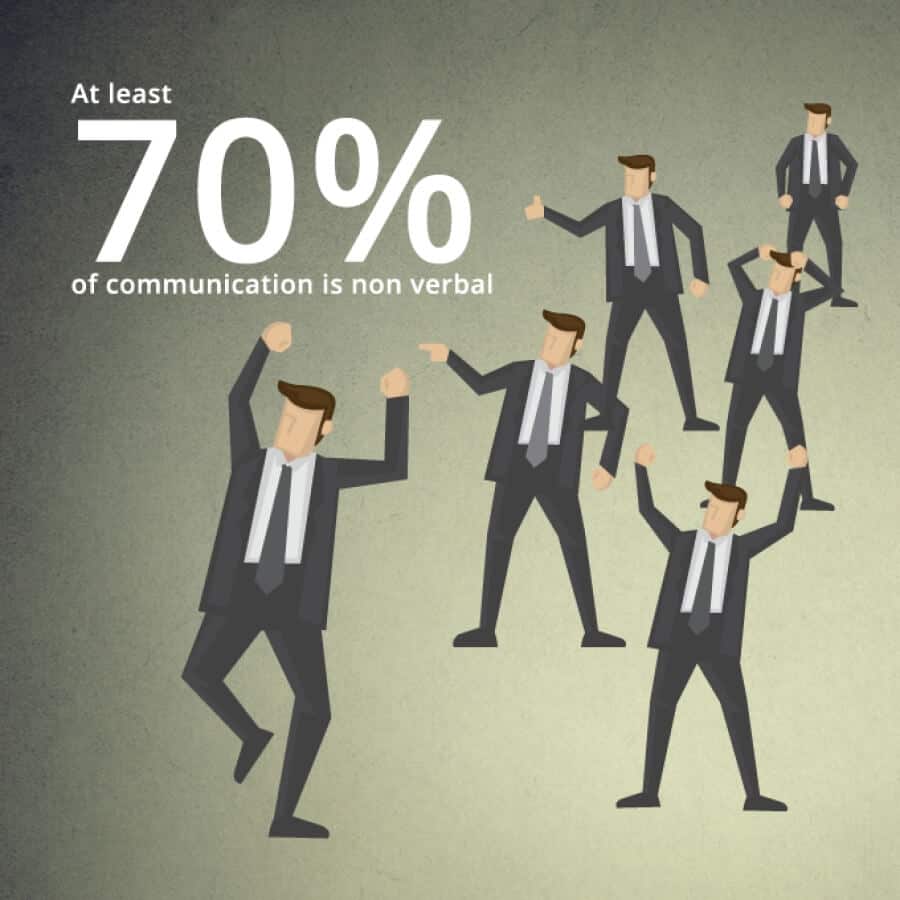As we all know, eye contact and just a look can communicate a million words. The old adage also goes, action speaks louder than words. Depending upon which research paper you refer to, the percentage mostly varies from 70 to 93 percent.
At Least 70 Percent Of Communication Is Non Verbal
There are also those who will tell you that it’s all bunkum. Philip Yaffe goes on to indicate, the research of Professor Albert Mehrabian and all that his book Silent Messages stands for is inaccurate.
Though, Philip Yaffe mostly relies on the fact that a well constructed speech which depends on words, is more meaningful than a badly constructed speech that is well delivered. He has a point.
But do we in our day to day communication with family, friends, colleagues and strangers go about giving speeches? Is average conversation about eloquence?
Professor Mehrabian’s studies
Let us give a quick look to Professor Mehrabian’s studies. He is known for his pioneering work in the field of nonverbal communication, mainly body language. His extensive efforts have been, both towards theoretical and experiments that have helped identify nonverbal and subtle ways in which people convey:
- like-dislike,
- power and leadership,
- discomfort and insecurity,
- social attractiveness,
- persuasiveness,
- and ways to detect when others are being deceptive in communication.
He quite succinctly was able to explain how the voice, such as tone, intonation and volume, take up about 38 percent and most of a person’s communication; about 55 percent, comprises of body language. Thus, it leaves only 7 percent to the words actually being spoken. This 7, 38, 55 model is probably as relevant today as it was, when he first presented his study way back in the 70’s.

Microexpressions
Paul Ekman, the famous professor of psychology took all of this many steps further with his books Emotions Revealed and Unmasking the Face. But also his association with the investigating authorities in identifying when the criminals were lying and able to beat the polygraph; more commonly known as the lie detector. His studies relate mainly to micro expressions.

We have been reading a fair amount in the recent days about pulling someone towards him and giving him a more than vigorous handshake and about the strong handshake where the knuckles went white. Is this about insecurity or is this about communicating power or both, or even about one-upmanship, added to that? All of it done, without words.
The university of Pennsylvania, has published a paper which is worth more than just a casual read. The paper titled The Art Of Communication deals with some of the basic aspects of relating with other people. This paper gives good tips for the average person on how she/he can improve on methods of communication and thus get a more empathetic reaction from others.

“Bubble Area”
One of the aspects the paper talks about is respecting a person’s personal space. They call this the “Bubble Area”. According to them the space a person needs from another is approximately one meter. In the opinion of the writer of this article, this is perhaps true of the American culture and the need for personal space varies from country to country.
For example, research supported by the Plainmath platform shows that one meter would be considered too far in France and the Czech Republic and the same one meter would be considered too close in many of the Asian countries.
The other body language tips they give could be quite useful to many. The basic one is what they call SOLER. This is about smile, openness, leaning forward, eye contact and a relaxed body form.
They further go on to talk about the voice. This is about the voice being well modulated and should be at a medium tone and volume. This again is perhaps subject to debate because what would be medium volume in the U.S. might be considered loud in many other countries. So here again one has to pay attention to where one is.
Mirroring the other person’s body language happens automatically between two individuals who have a natural empathy for each other.
Many feelings are communicated non verbally. Research also shows it is impossible not to send non verbal messages during communication.
There are also many schools all over the world that specialize in teaching body language skills. Sales persons reputedly practice many of the body language moves in order to get a better response.
If not 93 percent, perhaps the minimum level of 70 percent of the communication being non verbal is true.
Photos: Shutterstock / Collages: Martina Advaney
Support us!
All your donations will be used to pay the magazine’s journalists and to support the ongoing costs of maintaining the site.
Share this post
Interested in co-operating with us?
We are open to co-operation from writers and businesses alike. You can reach us on our email at cooperations@youthtimemag.com/magazine@youthtimemag.com and we will get back to you as quick as we can.









